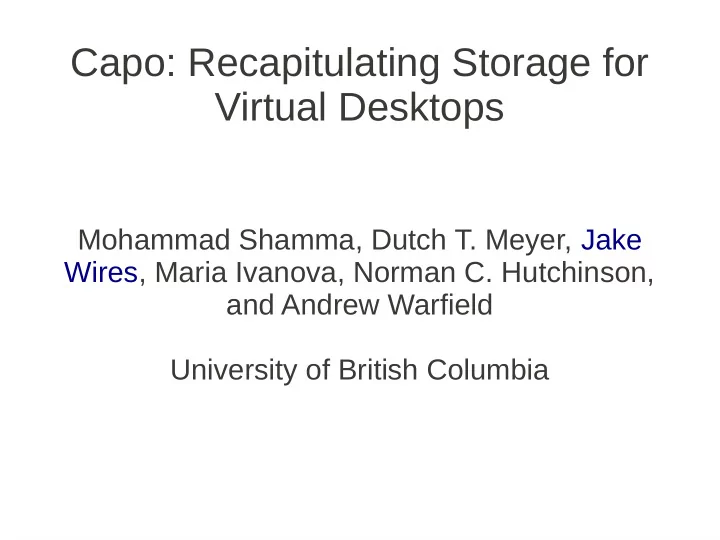

Capo: Recapitulating Storage for Virtual Desktops Mohammad Shamma, Dutch T. Meyer, Jake Wires, Maria Ivanova, Norman C. Hutchinson, and Andrew Warfield University of British Columbia
The World According to Gartner ● 60% of all enterprises will deploy network computers by 2001 ● 5 – 30 million Windows terminals sold per year by 2005 ● 40% of desktops – 49 million – will be virtualized by 2013 Sooner or later they're bound to be right
Virtual Desktop Infrastructure (VDI) ● IT admins love it ● Centrally administered ● Reduced hardware and maintenance costs ● Users will embrace it (hopefully) ● Familiar personal computing environment ● Performance (latency) is critical
Improving VDI ● How can we: ● Reduce the cost of VDI deployments? ● Improve the user experience?
Outline ● Background ● How VDI Works ● UBC Workload Analysis ● Design and Implementation ● Evaluation ● Conclusion
How VDI Works ● Sparse allocation ● Fast clone
How VDI Works User data isolated from system data
How VDI Works Patch Tuesday
UBC Workload Analysis
UBC Workload Analysis ● We profiled 55 Windows Vista desktops ● Administrative offices at UBC ● Installed profiler during regularly-scheduled weekly update ● Captured file- and block-level accesses ● Collected 75 GB of compressed, binary logs
Workload: Day-to-Day Activity ● Workload is quite bursty ● What do the requests look like?
Workload: IO Requests
Workload: IO Requests ● Most accesses to system-controlled objects (\Windows, \Program Files) ● Metadata-heavy workload ● IOps: 65% writes; throughput: 65% reads ● What do these writes look like?
Workload: Write Requests ● Fairly high churn rate ● 8% of bytes re-written in 10 seconds ● 50% of bytes re-written in 24 hours ● Average divergence of 1GB after about an hour ● A large portion of this is from pagefile.sys and other Windows files
Workload Summary ● VDI workloads are bursty ● Significant sharing among VMs ● High churn rate for hot data ● Namespace not accessed uniformly
VDI Storage Scalability How can we improve VDI storage scalability?
Local Persistent Cache ● Goal: offload IOps to local disks ● Library in dom0 interposes on access to network files ● Cached files stored on local file system ● Bitmaps track sparse files ● Supports write-through and write-back with adjustable window
Multihost Preloader ● Goal: share local caches among all hosts ● NFS proxy snoops requests to cached files ● Shared data is multicasted to all subscribed hosts ● Basic congestion control and/or isolated network required
Differential Durability ● Goal: reduce writeback burden ● Data categorized according to value ● User-created data, installer data, temporary files, pagefile.sys ● Gold Image disk partitioned ● Valuable data placed on a disk with an aggressive write-through policy ● Expendable data stored on cheap local disks
Capo Architecture Diagram
Implementation ● Local cache prototyped during summer internship ● 7,000 lines of C code ● Prefetcher implemented three (3) times ● Packet capture, unfsd, RPC proxy ● IntelliCache TM now available in latest XenServer releases
Outline ● Background ● How VDI Works ● UBC Workload Analysis ● Design and Implementation ● Evaluation ● Conclusion
Microbenchmarks: Preloading
Trace Replay: Methodology ● Original environment: ● VMware ● SAN ● Our lab: ● XenServer ● Linux NFS filer w/ 6-disk RAID 0 volume ● Replayer: ● Simple perl application ● Tries to match original trace request pattern
Trace Replay: Selected Peaks
Conclusion ● VDI presents new challenges for storage systems ● Central storage is a reasonable solution... ● But local caching and differential durability can help reduce costs and improve performance
Questions?
Recommend
More recommend